-
 एक ऑनलाइन मीटिंग की मेजबानी करने जा रहे हैं, तो यहां 10 सर्वश्रेष्ठ वीडियो कॉलिंग ऐप हैं जिन्हें आपको आज़माना चाहिए। वीडियो कॉल को बेहतरीन अनुभव कैसे बनाएं? (2020)
एक ऑनलाइन मीटिंग की मेजबानी करने जा रहे हैं, तो यहां 10 सर्वश्रेष्ठ वीडियो कॉलिंग ऐप हैं जिन्हें आपको आज़माना चाहिए। वीडियो कॉल को बेहतरीन अनुभव कैसे बनाएं? (2020)
-
 Worried about Frizzy and Unmanaged Hair? Get Gorgeous and Trendy Hair Style with These 10 Best Philips Hair Straightener (2020)
Worried about Frizzy and Unmanaged Hair? Get Gorgeous and Trendy Hair Style with These 10 Best Philips Hair Straightener (2020)
-
 Are You Looking for a Water Purifier to Suit Your Sleek Modular Kitchen(2021)? 10 Best Under Sink Water Purifiers to Save Room in Your Kitchen
Are You Looking for a Water Purifier to Suit Your Sleek Modular Kitchen(2021)? 10 Best Under Sink Water Purifiers to Save Room in Your Kitchen
Best Telescope for Beginners to Transform a Casual Stargazer into an Astronomy Enthusiast
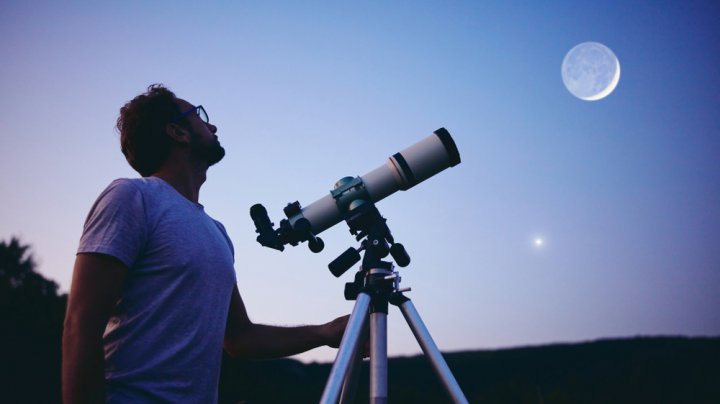
Astronomy is one of the most, if not the most, fascinating fields in science; the distant stars, billions of planets in the universe, the ever-expanding universe itself, they all make you wonder the trillions of possibilities which could be out there, the possibility of extra-terrestrial life, and that there is so much to explore out there!
Do you happen to absolutely love those mesmerising photos of distant galaxies and solar bodies released by NASA and other space agencies? Do you just want to keep looking into the night sky once the sun sets? If “yes!” is what your heart screamed for these questions, then a telescope is what can help you quench your thirst of curiosity related to the solar system. You can start your journey by buying a telescope for beginners, and once you get familiar with all the technicalities, you can move towards an advanced one and see yourself transform from a casual stargazer into an astronomy buff!
Let us begin by taking a look at a brief buyer’s guide with the types and specifications you must be aware of before buying you first telescope!
Different Types of Telescopes & Specifications to Look For
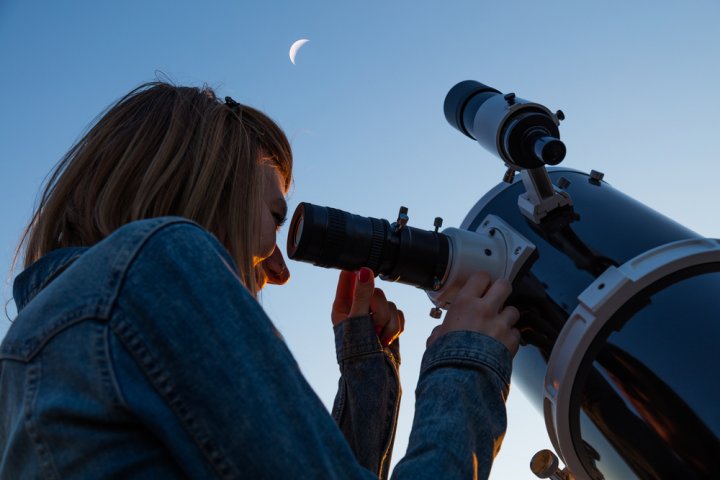
3 Main Types of Telescopes
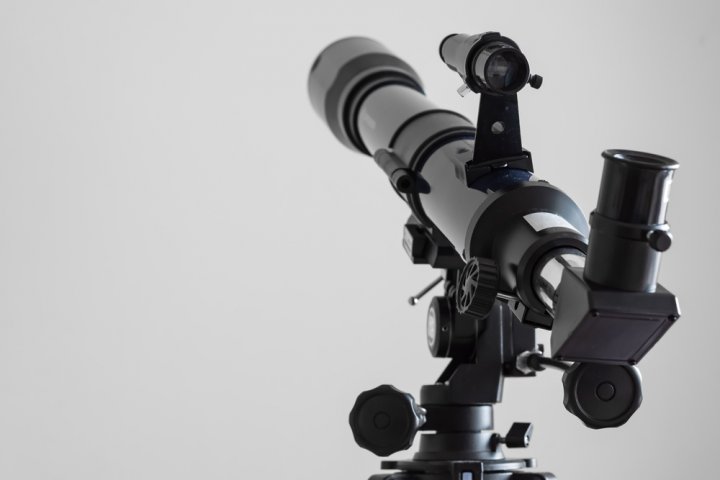
Refractors:
As the name suggests, these are based on the principle of refraction and use different kinds of lenses to create the image on the eyepiece. These are the easiest ones to maintain as they only require you to clean the lenses, and that’s it! Overall, these will suit you the best if you have a limited budget (and if you’re a beginner to astrophotography), but still want to capture satisfying space photographs.Reflectors:
These use the principle of reflection and project the photograph on the eyepiece using a mirror. These are on the moderate side price-wise but require more effort from your side in terms of maintenance, as they come with more pieces of equipment.Catadioptric or Compound or Cassegrain:
These are a mixture of refractor and reflector telescopes and use combination of both lenses and mirrors to display the picture on to the eyepiece. These are the most expensive ones among the three types and require the highest maintenance. However, if you can shell out several thousand, then you can definitely go with them for they are really suitable for beginners.
Aperture: One of the Most Crucial Aspects
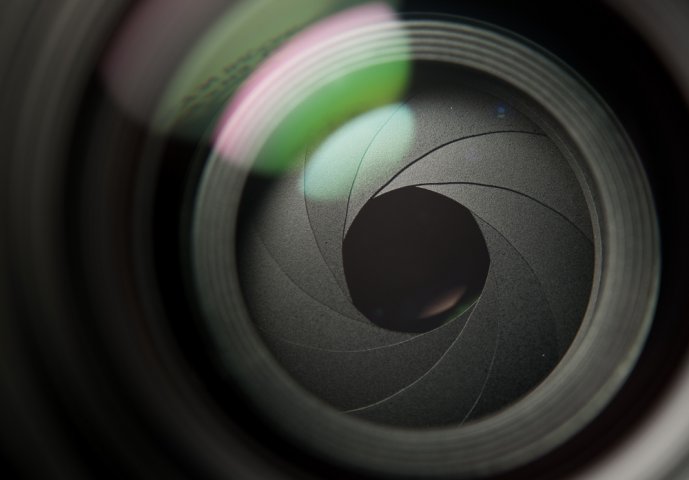
Aperture decides the quality of images you would be able to see with your telescope. The higher is the aperture of the telescope, the better the quality of the image you will be able to see. Hence, it makes sense to go with telescopes with higher apertures.
Ease of Carrying & Practicality
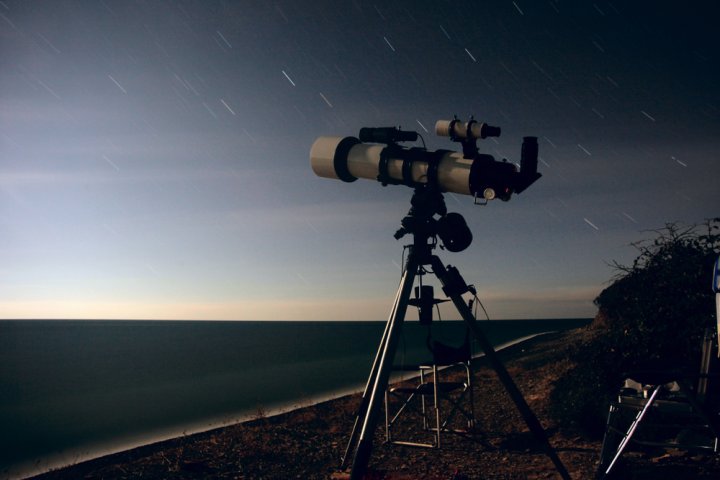
You would want to carry your telescope to remote places, from where you can see stunning skies without any light and dust pollution, and a lighter telescope will prove to be of much utility here. You wouldn’t want to be carrying a bulky refractor telescope around to find that perfect spot for exploring the skies!
Mounts & Telescopes That Can Be Controlled with Software: GoTo Telescopes

The mount of the telescope is what keeps it steady while watching astronomical objects perfectly. The two main types of mounts telescopes come with are altazimuth and equatorial. For beginners, altazimuth is the ideal choice as it only includes moving the mount in two motions, viz. horizontally and vertically. On the other hand, equatorial telescopes’ movements are based on the rotation of the earth, which helps capture the picture accordingly; although the latter is a better choice, they are a bit difficult to get a hold of in the beginning.
Then, one of the more recent additions have been the GoTo mounts, which can be controlled via your computer. You can just give a command to find a particular object, and they would do it for you! If you want to learn astronomy, then these might not be the right choice for you as they make the work very easy; so, if you want to get the most out of a telescope if you’re just starting, altazimuth may be a perfect choice!
9 Best Telescopes to Buy for Beginners

Let us now see some of the best telescopes for beginners:
Orion Goscope III 70mm Refractor Special Travel Telescope Kit
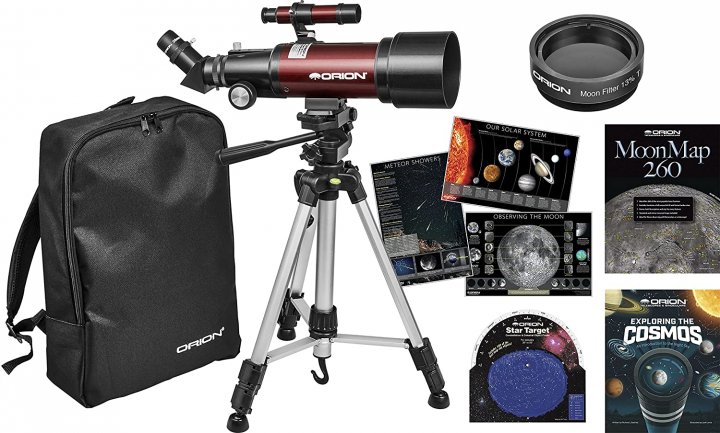
If there's one telescope any beginner can go with, it's this telescope kit by Orion – it comes with everything you need for starting stargazing right away! The tripod stand in this kit is adjustable up to 43.5 inches, and the lowest it can go is up to 17.75 inches. Its focal length is 400 mm, through which you will clearly be able to see the moon and be able to see up to the rings of Saturn. As a secondary use, you can also use it for casual birdwatching and viewing wildlife. The package comes with an Orion moon filter, Orion Star Target Plan sphere, Orion Exploring the Cosmos book and Orion poster kit.
It comes with two eyepieces (20 mm and 9 mm), with an objective lens diameter of 400 mm. It is imported in India, and you can order it from Amazon for about ₹ 24,000.00.
Celestron PowerSeeker 50 AZ Refractor Telescope
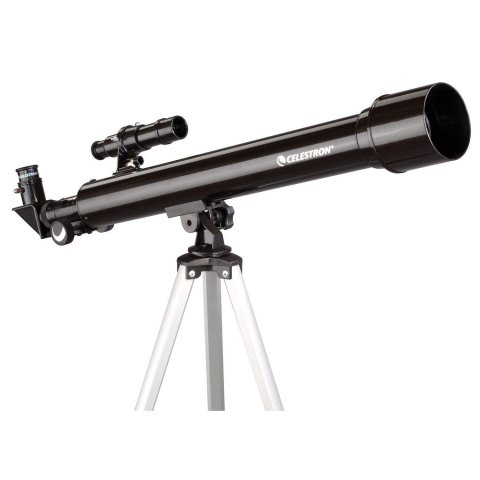
Another fine choice for a telescope for beginners is the PowerSeeker series by Celestron. Through this telescope, you would be able to see the Andromeda Galaxy and the Orion Nebula at nights. Its mount is manual alt-azimuth, perfect for beginners, which would allow you to observe the objects by moving the eyepiece left/right/up/down. In the PowerSeeker 50's package, you will find four eyepieces (4, 12, 20 mm, and 1.5x for image erecting), star diagonal (helps in right-side-up viewing), finderscope (to align the object you're viewing at the centre), and a 3x Barlow lens (which is there to triple the magnifying power of each eyepiece). You can also use Celestron's Starry Night software to enhance your knowledge of astronomy and celestial objects.
It comes with a focal length of 600 mm and an aperture of 50 mm. As you move down the series, the aperture would keep increasing. You can order it from Amazon or find a retail store at Celestron.
Esako Telescope for Beginners & Adults 70mm Astronomical Refractor Telescope
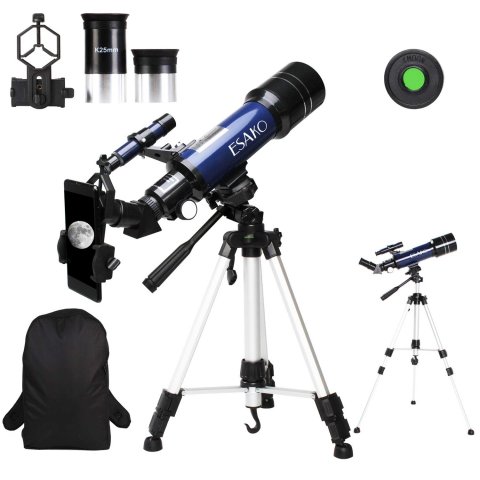
Esako's telescope for beginners is a choice you cannot go wrong with! A perfect telescope for kids, and astronomy beginners, this one comes with a 70 mm aperture, 400 mm focal length and it offers a magnification of up to 190x. The tripod that comes with it has a range of 16.1 inches to 40.1 inches. You will also find a phone adaptor in the package to easily record what you're viewing, a finder to easily locate astronomical bodies, 1 Barlow lens, 1 moon filter, 2 eyepieces (25 mm, 6 mm), an erect diagonal lens, and a carry bag to make sure you can comfortably take it all up with you on your next trip! You can purchase this telescope from Amazon.
Celestron Speciality Series Travel Scope 70 Telescope

This Celestron model is quite different from the earlier one, and you'd get to see a few more from the house of Celestron, for they make some of the most reliable telescopes for beginners! Celestron Speciality Series Travel Scope 70 Telescope comes with a focal length of 400 mm, with an aperture of 70 mm, suitable for watching both far-away objects in space, as well as on the ground. The maximum magnification it offers is 168. You also get "The SkyX" – a software that comes packed with over 10,000 object database, 75 enhanced images, and printable sky maps. This telescope for beginners can be bought from Amazon for about ₹ 32,000.00.
Orion 9823 Apex 102mm Maksutov-Cassegrain Telescope
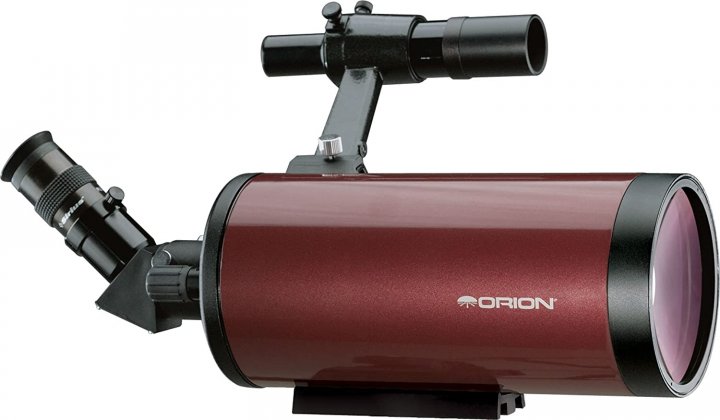
This option is a bit above entry-level telescopes, so you might have to spend a little more time getting hold of how to use this telescope properly, but if you want a good mid-range telescope, it will suit you well!
It's a compound one, having a 102 mm aperture and 1,300 mm focal length, which would provide you marvellous views of galaxies and even distant grounds. The package includes a 1.25 inches eyepiece, 6x26 correct-image finder scope, 45° correct-image diagonal, soft carry case, and Orion's Starry Night software. So, if you have got a fair idea about how telescopes function, and you're past the beginner's stage, you can go for it! Please note that it does not come with any accessories, such as a tripod stand, mounts, etc., and you would have to buy them separately. It is available for purchase on Amazon.
Celestron AstroMaster 76EQ Telescope
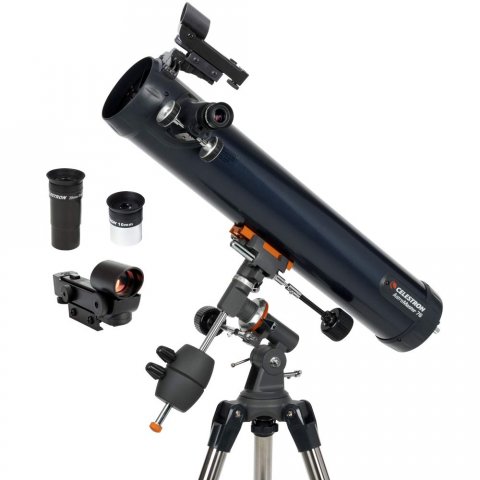
The next masterpiece from the house of Celestron is this Celestron AstroMaster 76EQ, a reflector type telescope, which comes with a focal length of 700 mm, and an aperture of 76 mm. The mount included with this product is the equatorial one, which allows you to view (or capture) the sky's rotation and track objects conveniently.
The set-up comes pretty much assembled, and you can start with your sky-gazing journey within minutes! As with other Celestron products, this also comes with SkyX astronomy software, which comes with thousands of images in its database. Overall, a fantastic product for beginners! You can have a look at it on Amazon.
Celestron NexStar 4 SE Telescope

Next on the list is a fully automated telescope to which you will just have to give the command, and it will locate the celestial object for you! You can even track long-exposures with this telescope, thanks to its built-in wedge. Its focal length is 1,325 mm, with an aperture of 102 mm. The highest magnification provided is 241x, which will you crisp images of planets as fat as Jupiter. As it's an automated telescope, the mount included with this telescope is Computerized Altitude-Azimuth Single Fork Arm, and it also comes with an aux port. Additionally, the star pointer finderscope and the accessory tray will be of much help to you when you're watching the skies. It is on the costly side, and you will have to shell out approximately ₹ 85,000.00 to lay your hands on this beauty! You can order it from Amazon.
Orion SpaceProbe II 76mm Altazimuth Reflector Telescope
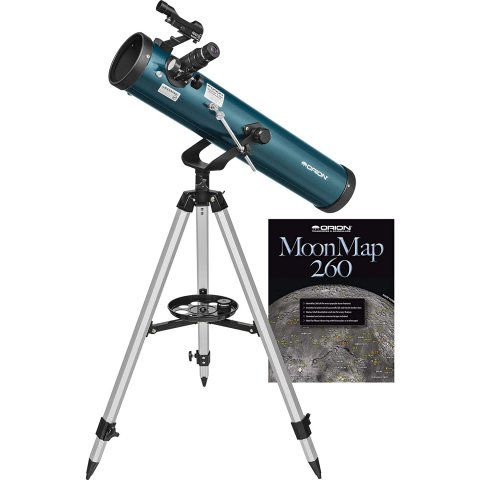
For our penultimate option, we have the Orion SpaceProbe II, a reflector telescope with an altazimuth mount. The telescope will enable you to see the moons of Jupiter and even some bright nebulas if you get to learn your way around using it properly.
Its primary mirror is 76 mm long and included eyepieces having a length of 25 mm and 10 mm each, and an aperture of 3 inches. There is a red dot sight provided on the telescope tube, which greatly helps in focusing on the object you want to view. Also, Orion MoonMap 260 will help you clearly identify lunar features such as craters and valleys. It is a fantastic start if you are looking to own your first telescope. You can order it from Amazon for ₹ 39,283.00.
Celestron Nexstar 114SLT Computerised Telescope
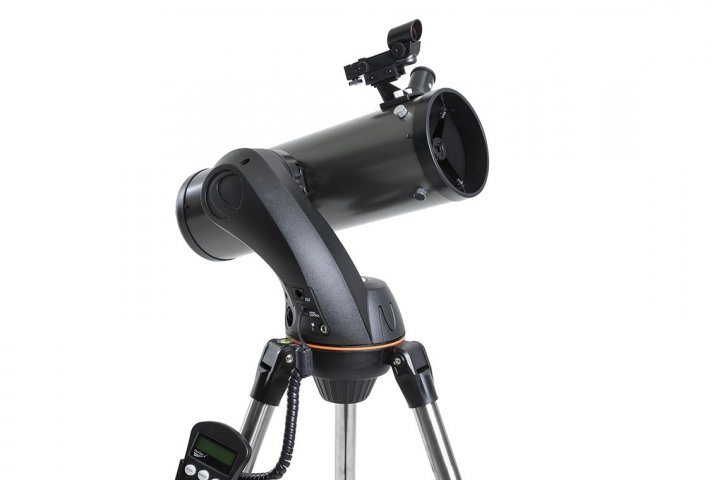
Here is the last option on this list, and we have selected another classy product by Celestron – a reflector telescope that comes with a fully-automated mount. It comes with several features limited to this particular series, such as the NextStar+ Hand Control, through which you can go through over 40,000 celestial objects at the comfort of pushing a button. The Next Star+ database also comes with a database having over 600 galaxies, 300 clusters, and many mesmerising binary stars, which would keep you engaged for a long-long time! Other accessories include a red dot finderscope, two eyepieces (25 mm & 9 mm). Additionally, this telescope is compatible with a majority of Celestron's latest accessories.
This 450 mm focal length and 114 mm aperture telescope is available for purchase on Amazon for ₹ 68,900.00, or you can also find offline dealers on Celestron.
Food for Thought – Alternatives to Telescope: Binoculars vs Telescopes for a Beginner

Binoculars have long been associated with watching ground-level objects, however, with the advent of modern-day technology, astronomical binoculars have seen the light of the day, which enable you to see celestial objects clearly to an extent.
So which one to go for – astronomical binoculars or a telescope? The answer isn't objective to this question, as even though binoculars are a great addition to the world of astronomical instruments, their relatively small size is a catch that is yet to be overcome as this doesn't allow it to display pictures of far-away bodies as clearly as a telescope. So, if you're starting with your astronomical journey, a telescope is a must-have, while a pair of astronomical binoculars will be a great add-on to your collection of instruments, and not to forget, you can easily carry it around on your ground tours!
-
 Looking for a Low Budget Smartphone? Top 12 Mobiles Under 10000 Rupees in India in 2019, Handpicked for Each and Every Need of Yours!
Looking for a Low Budget Smartphone? Top 12 Mobiles Under 10000 Rupees in India in 2019, Handpicked for Each and Every Need of Yours!
-
 एक बढ़िया स्मार्ट फोन का चयन करना काफी मुश्किल है, इसीलिए हम आपके लिए पूरी मार्केट में से 10 शानदार और लेटेस्ट स्माटफोन चुनकर लाए हैं जिनकी कीमत 10000 से कम है (2019)
एक बढ़िया स्मार्ट फोन का चयन करना काफी मुश्किल है, इसीलिए हम आपके लिए पूरी मार्केट में से 10 शानदार और लेटेस्ट स्माटफोन चुनकर लाए हैं जिनकी कीमत 10000 से कम है (2019)
-
 Mobile Holder is the Most Important Accessory to Carry Your Smartphone Securely. Check out Great Mobile Holder Options for Different Applications (2020)
Mobile Holder is the Most Important Accessory to Carry Your Smartphone Securely. Check out Great Mobile Holder Options for Different Applications (2020)
-
 Can't Figure Out the Best Water Softener for Your Home? A Complete Guide on Water Softeners, Things to Look for and the Best Alternatives in the Market (2020)
Can't Figure Out the Best Water Softener for Your Home? A Complete Guide on Water Softeners, Things to Look for and the Best Alternatives in the Market (2020)
-
 Style Your Hair to its Best with These Top Hair Straighteners for Men in 2020
Style Your Hair to its Best with These Top Hair Straighteners for Men in 2020
Do a Careful Market Research Before Buying a Telescope
Once you have decided to pursue astronomy as a hobby it is imperative that you do a careful market research before buying a telescope. After all, they don't come cheap and you should not end up buying a piece which does not meet your requirements. We hope this BP Guide would have helped you decide which telescope would meet your requirements and your budget the best. Stay connected with us for more such engaging content.


 Highlight the Best Facets of Your Incomparable Beauty: Discover the Best Face Highlighter Currently Available in India and Everything You Need to Know About Using Face Highlighters for Maximum Effect (2023)
Highlight the Best Facets of Your Incomparable Beauty: Discover the Best Face Highlighter Currently Available in India and Everything You Need to Know About Using Face Highlighters for Maximum Effect (2023)
 Forget the Blemishes and Get that Picture Perfect Flawless Radiance on Your Face: Check out the Best Foundations for Oily Skin Currently Available in India and Everything You Need to Know About Makeup Foundations (2023)
Forget the Blemishes and Get that Picture Perfect Flawless Radiance on Your Face: Check out the Best Foundations for Oily Skin Currently Available in India and Everything You Need to Know About Makeup Foundations (2023)
 Make Your Presence Felt Wherever You Go: Discover the Best Perfumes Under 2000 for Both Men and Women to Announce Your Arrival and Make Any Occasion Memorable (2023)
Make Your Presence Felt Wherever You Go: Discover the Best Perfumes Under 2000 for Both Men and Women to Announce Your Arrival and Make Any Occasion Memorable (2023)
 Protect Your Oily Skin from the Harmful Rays of the Sun: Discover the Best Gel Based Sunscreens for Oily Skin and Everything You Need to Know Before Buying One (2023)
Protect Your Oily Skin from the Harmful Rays of the Sun: Discover the Best Gel Based Sunscreens for Oily Skin and Everything You Need to Know Before Buying One (2023)
 Minor Blemishes and Wrinkles Affecting Your Confidence? Check out the Best BB Creams to Conceal Your Worries and Nourish Your Skin to Restore the Healthy, Radiant and Glowing Complexion Back Again (2023)
Minor Blemishes and Wrinkles Affecting Your Confidence? Check out the Best BB Creams to Conceal Your Worries and Nourish Your Skin to Restore the Healthy, Radiant and Glowing Complexion Back Again (2023)
